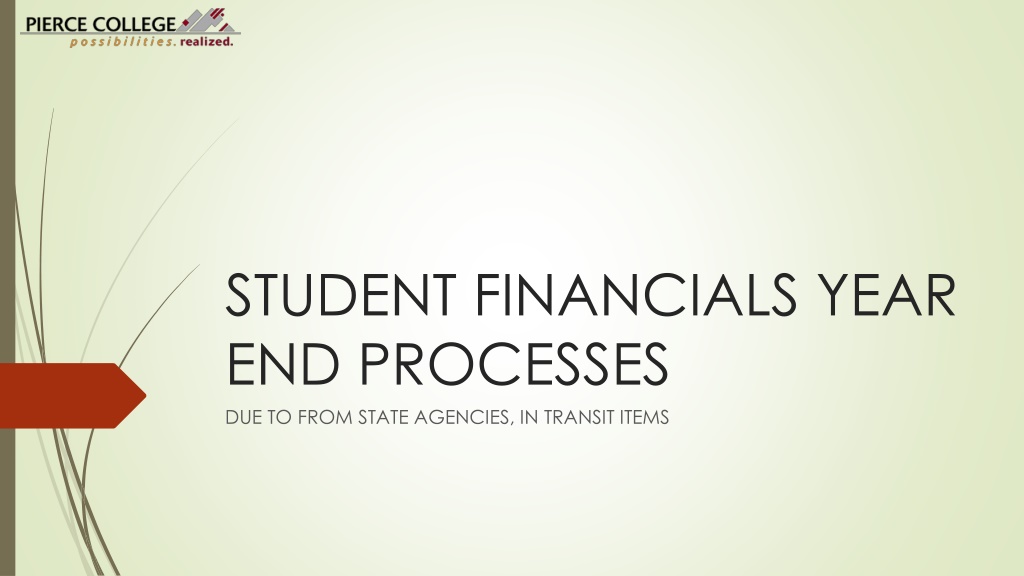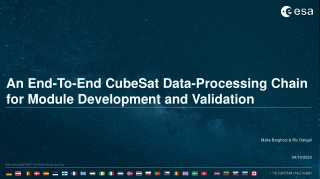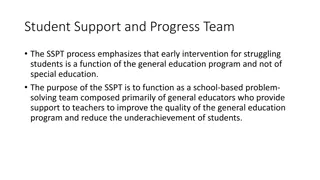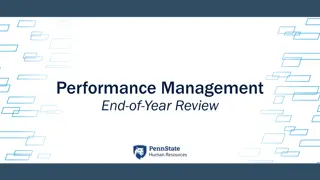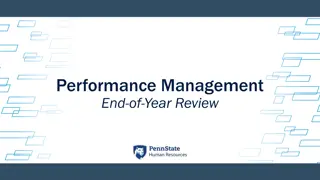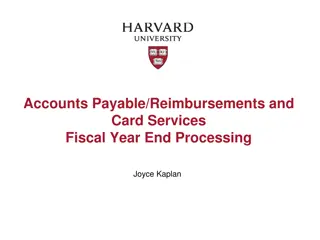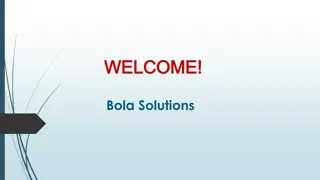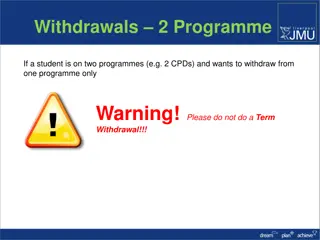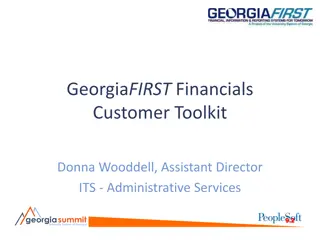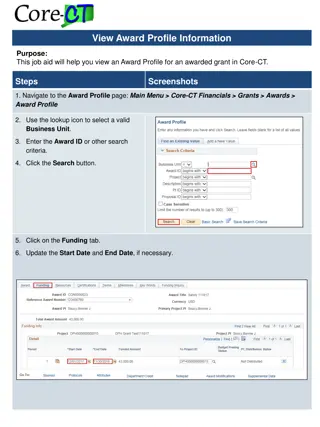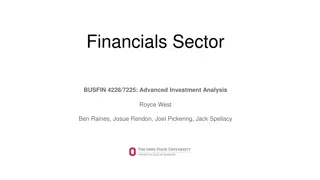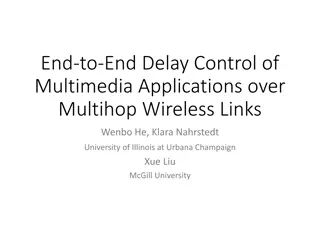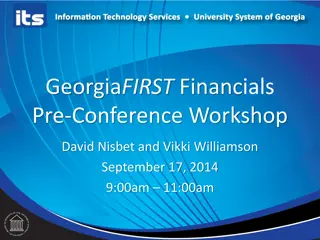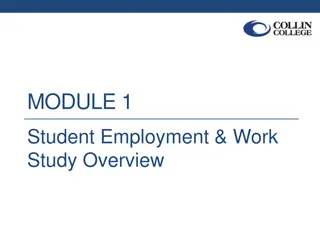Understanding Year-End Processes in Student Financials
Year-end processes in student financials involve closing out or billing all transactions for a school year, clearing holding accounts, resolving discrepancies, and verifying unpaid invoices with state agencies. Starting the process early, using tools like SMART reports, and balancing due-to-from accounts with agencies are essential for a smooth year-end close.
Download Presentation

Please find below an Image/Link to download the presentation.
The content on the website is provided AS IS for your information and personal use only. It may not be sold, licensed, or shared on other websites without obtaining consent from the author. Download presentation by click this link. If you encounter any issues during the download, it is possible that the publisher has removed the file from their server.
E N D
Presentation Transcript
STUDENT FINANCIALS YEAR END PROCESSES DUE TO FROM STATE AGENCIES, IN TRANSIT ITEMS
What does Year End for Student Financials mean? Year-end for Student Financials is basically closing out or billing everything for a specific school year. Clearing all holding accounts, so that you start the new year with nothing in these accounts. Resolving any discrepancies that you might have had that caused you to place payments into your holding accounts. This is also a good time to verify with all other State Agencies that what you are showing unpaid (invoiced) is what they will be paying or will carry over to the new year. It also gives you time to verify that everything that was billed was posted to the correct account, if not then you have time to correct it.
How early can I start the year end process? You can start the year end process at anytime during the year. While you are making corrections monthly, you are not always seeing everything that needs to be corrected. Some schools wait until the end of the year to start the process. While others start up to 6 months earlier. If at all possible use the SMART Report to help you start year end. This report will tell you what a lot of the issues are and where you can start the search for locating them.
What is the SMART REPORT? SMART stands for Standard Monthly Analysis and Review of Transactions. This system not only gives you the information you need to correct errors in your receivables, it also gives you information about cash, expenditures, revenue, Due to From, Other and Misc. information. If you aren t familiar with the SMART Report I strongly suggest that you become familiar with it. If you are using this report when you balance you re A/R Sub-Ledger and Allowances accounts it will make your year-end close go a lot smoother. This report also allows you to keep track of what you have invoiced to other agencies and Community Colleges. Web address http://smart.sbctc.edu/chklist.asp
What is the Due to From Process? The Due to From Process is basically where you match your receivables to each State Agency and Community Colleges Payables. Let s say I have a receivable balance for Clover Park Tech. in the amount of $4,653.42 but their payables only has them owing us $3116.53. Before we can close for year end we must balance with each other. To bring myself in balance I would need to send a list of invoices that I am showing as still outstanding to Clover Park, and they would be able to tell me if they paid the invoice or have not received it yet. Once they receive that list they would then check to see what they have pending against what I sent. They would either request a copy of an invoice or give me the information of when it was paid. Please note that not all schools start this process early and upload SMART daily or even monthly. You would also do this same process for any other State Agency such as DSHS. Currently only Community Colleges and Tech Colleges close as of June 30th. All other State Agencies close in September. If you cannot get the other State Agencies to balance with you by our final June close, you might have to ask SBCTC to do a manual correction to bring you into balance with the State Agency before they close in September.
Smart Screens needed for closing the year-end Here is a review of the screens you will need to monitor for mistakes: The first screen 112: Allowance Accounts. The 112 screen is the one we covered in the section Allowances. The second screen is the 305: Miscellaneous Other Sources GL32XX. The 305 screen is the one where you can see anything you have put in a holding account with the revenue source of 0920-0940. The last screen is the 502: Receivable/Payable Changes with No Current Activity. The 502 screen uses the general ledgers and will show you everything that isn t paid or has not yet been refunded. When year-end is completed you should not have anything showing in the 305: Miscellaneous Other Sources, other than your 0409 source of revenue. Also, the 502 Receivable/Payable screen should not show anything from accounts receivable by year- end. Examples of all screens are below.
What does in transit mean and how do I process in transit payments? You only use this process at the end of the year. A lot of agencies will generate payments just before the end of June (June 30th)but not get them out in the mail until July 1stor later. Sometimes you don t receive the ones mailed before the end of June until after July 1st. If a check from a State Agency or Community College has a date prior to July first you would need to record a Deposit in Transit. Instruct your cashiers to not deposit any checks that are from a State Agency or Community College if they have a date on them of June but were received in July. These checks will arrive sometime in the first week of July in most cases. But you will want to have your cashiers keep a look out for them until the middle of July just to be safe.
How to record a Deposit in Transit When a check is received prepare a GAT form to reverse the receivable accrual (TC 150R, 3205/1354) or (TC147, 6505/1354). Next, credit cash revenue or cash expenditure and debit deposits in transit (TC029, 1120/3210) or (TC030, 1120/6510). One way to make this a lot easier is have a cashier pay a receivable in their session, only this payment, then close their batch and deposit the check. The next morning use the information for the cashier batch from the GA1202 as the backup for your GAT. See example below.
Reversing the receivable and Deposit- in-Transit in the New Year Copy and reverse the above entries and enter a reversal into July. The check can be processed and deposited in July with no change in existing procedures. The batch you copied and reversed into July will offset the entries automatically generated in July, when the payment is recorded. The net effect of the reversed batch and the automatically generated entries, will be to debit cash (GL 1110) and credit deposits in transit (GL 1120). Note: In the new year it is important to remember to reverse a deposit in transit established in the old year. At the end of July there should be no remaining balance in (GL 1120). One way to remember to reverse this is to do both entries on the same day (such as, back date the first one into June and then right after reverse it into July). Example below.
Questions?? Presented by: Terri Mitchell Student Financial Mgr. If you have questions after you leave please contact me at: tlmitchell@pierce.ctc.edu or by phone 253-964-6715
